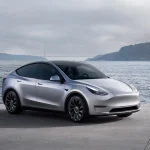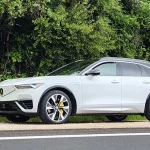
How the Sono Sion electric car will use every body panel as a solar panelHow the Sono Sion electric car will use every body panel as a solar panel
In a sea of electric-car startups, Sono Motors has no problem standing out.
The Munich-based company aims to build an unpainted plastic-paneled, solar-cell-covered urban hatchback primarily for Europe. It’s been largely crowdfunded—most recently, with a successful $58 million round. And the car will be made with China’s NEVS at the Trolhättan, Sweden, plant that produced generations of Saabs.
Although Sono is working with Finland’s Valoe Oyj for solar components, Germany’s ElringKlinger for the battery systems, and Continental for drive components, it’s doing a lot of the development work on its own. That includes some “first ever” work to be done in managing the power trickling in at different rates from the Sion’s solar modules.
Up until now, solar cars have packaged their cells largely on the same plane—the roof. Solar cells only produce their peak power when the sun is directly overhead, and hitting the panel at a 90-degree angle. Having solar cells on all the panels—248 of them in the Sion—can mix that up in a helpful way, creating angles in which at least one of the panels is somewhere close to peak even if other panels aren’t.
Sono Sion electric car solar panel placement
That patchwork creates new issues. Connecting the solar cells isn’t as easy as it sounds—especially when, as Sono intends, you integrate those cells at several points in the body.
“Not every cell generates the same amount of power, because our energy supplier, the sun, moves constantly,” the company’s photovoltaic power electronics expert explained in a company blog post from earlier this month. “Furthermore, not all solar cells on the Sion point in the same direction.”
To that, it’s devised a Maximum Power Point Tracking central unit to adjust the load on solar modules individually, so the cells in that module can perform to the optimum level. With the new unit, the Sion converts to the voltage of the high-voltage battery, between 300 and 400 volts, in a single process that aims to reduce losses.
So far Sono is claiming a 94-percent efficiency from this converter. Whenever the coronavirus pandemic allows, Sono aims to expand testing in Munich, using simulators to fine-tune the system to potential light and temperature conditions.
Sono Sion solar assisted electric carSono Sion solar assisted electric carSono Sion solar assisted electric car
Sono hasn’t backed away from its optimistic numbers in what it claims to be able to generate from the sun: up to 3,600 miles per year from the sun, or a daily average of just under 10 miles year-round.
You might see dramatically more or less depending on what time of the year and the level of cloud cover, of course. In Munich, Germany, for instance, it estimates up to 21 miles per day. Sono plans to offer predictive tools that are based on meteorological data and the car’s location to help plan maximizing solar-power benefits.
In the Sion, the solar cells are embedded in clear polymer rather than in glass, which the company says makes them 20% lighter than comparable metal panels—as well as capable of producing more power per area (up to 220 watts per square meter) than existing flexible or glass photovoltaics.
Sono Sion electric car solar panel placement
Sono plans to use NMC 622 prismatic cells, with 12 per module and a total of 16 modules in 35-kwh water-cooled pack. That will provide a total range—when you either plug in or wait long enough—in the vicinity of 160 miles. Sono has in the past floated the possibility of leasing or buying the pack separately from the rest of the vehicle, to help keep the price down.
Sono now anticipates launching its development prototypes in late September of this year—slightly later than previously anticipated. And the company confirmed last week to Green Car Reports that it plans to produce its first vehicles on the line at the end of 2021, with an official start of production and first deliveries to start in early 2022.
View original article at: “https://www.greencarreports.com//news/1128254_how-the-sono-sion-electric-car-will-use-every-body-panel-as-a-solar-panel”
Add a comment Cancel reply
Comments (0)
Uodiyala
… [Trackback]
[…] Read More to that Topic: autoseu.com/how-the-sono-sion-electric-car-will-use-every-body-panel-as-a-solar-panelhow-the-sono-sion-electric-car-will-use-every-body-panel-as-a-solar-panel/ […]
Categories
- Activism (1)
- Adventure (1)
- Advertising (2)
- Agriculture (1)
- Air pollution (4)
- Air transport (3)
- aluminium (2)
- Amazon (3)
- Animals (1)
- Apple (2)
- Architecture (1)
- Arctic (1)
- Artificial intelligence (1)
- Augmented Reality (1)
- Auto Detailing (1)
- autopilot (1)
- battery (31)
- Best summer holiday destinations 2022 (1)
- Bicycle (1)
- biodiversity (1)
- BMW (2)
- boat (1)
- Bus (1)
- Business (4)
- Buying Guides (1)
- car (7)
- Car industry (18)
- Car News (18)
- car rental (3)
- Car Reviews (4)
- Car sales (6)
- carbon emissions (15)
- carbon footprint (3)
- Carlos Ghosn (1)
- Cars (66)
- Central Europe (1)
- CES (2)
- charging station (11)
- Children (1)
- China (12)
- Citroën (1)
- city (1)
- City transport network (2)
- clean energy (2)
- Climate (1)
- climate change (9)
- Climate crisis (4)
- Climate emergency (2)
- climate protection (2)
- CO2 emissions (39)
- Company (3)
- Competition (1)
- Conscious travel (2)
- Contamination of water (1)
- Copper (2)
- cost of living (2)
- Cuba (1)
- Cuban politics (1)
- Cybertruck (1)
- Cycling (1)
- deforestation (1)
- delivery (3)
- Denmark (2)
- Detroit (1)
- Diesel (4)
- Diesel car (7)
- e-mobility (11)
- e-scooter (2)
- Eco travel (3)
- Eco-friendly (2)
- Ecology (1)
- Economy (1)
- El Niño (1)
- Electric (11,302)
- Electric boats (1)
- electric car (107)
- Electric Cars (499)
- Electricity (5)
- Electricity consumption (3)
- Electricity market (5)
- Elon Musk (21)
- emission (1)
- Emmanuel Macron (1)
- Energy (2)
- Energy low cost (1)
- energy transition (6)
- Entrepreneur (1)
- Environment (5)
- Environment pollution (1)
- Environmental protection (4)
- EU Policy (1)
- EU-China (2)
- Europe (7)
- Europe's energy crisis (1)
- European Commission (3)
- European economy (2)
- European Union (18)
- Euroviews (6)
- Eviction (1)
- EVs (37)
- F1 (1)
- factory (4)
- fake news (1)
- family (2)
- Ferrari (1)
- fertilizer (1)
- fine (penalty) (1)
- fire station service (1)
- flight (1)
- Flying car (4)
- Food security (1)
- Ford (1)
- Formula 1 (2)
- Fossil fuels (14)
- France (39)
- free trade (1)
- Fuel (3)
- Fuel cell electric vehicles FCEV (10)
- fuel crisis (2)
- Fuel Efficiency (3)
- fuel prices (1)
- Funeral (1)
- Gas (1)
- Gas Prices (1)
- gasoline price hike (1)
- German (1)
- Germany (8)
- Giorgia Meloni (1)
- Global warming and climate change (1)
- Good News (1)
- Greece (1)
- green energy (1)
- green new deal (1)
- Green transportation (17)
- Green Week (1)
- greenhouse gas emissions (6)
- Hanoi (19)
- Health (1)
- home (2)
- homelessness (1)
- Housing market (19)
- human rights abuse (1)
- Hybrid (2,283)
- Hybrids (116)
- Hydrogen (2)
- hydrogen vehicle (2)
- IAA Mobility (2)
- Iceland (3)
- incident (1)
- income (1)
- India (2)
- Indonesia (1)
- infrastructure (1)
- innovation (1)
- International relations (1)
- Investment (4)
- iPhone (1)
- Japan (1)
- Jobs (3)
- Joe Biden (4)
- Jubilee (1)
- Lampedusa (1)
- Las Vegas (1)
- lead petrol (2)
- Lithium (13)
- liveable cities (2)
- London (3)
- Luxembourg (1)
- Luxury (2)
- luxury goods (2)
- Luxury lifestyle (2)
- Manufacturing (5)
- Market (1)
- Markets (1)
- meat (1)
- Mercedes-Benz (39)
- Migrants (1)
- minerals (2)
- Mining (5)
- Mitsubishi Motors (1)
- Mobile World Congress (1)
- Mobility (10)
- Mobility Week (2)
- Mobility Week 2021 (1)
- Mobility Week 2023 (5)
- money (3)
- Motorcycling (2)
- Motorsport (1)
- Mountain (1)
- NASA (1)
- nature (2)
- net-zero (2)
- New technologies (6)
- Next Explainers (1)
- Next In data (2)
- Nigeria (1)
- Nissan (3)
- Norway (7)
- Nuclear Energy (1)
- nuclear fusion (1)
- Nuclear power plant (1)
- Odd (1)
- oil industry (1)
- Olaf Scholz (1)
- online shopping (1)
- Oslo (1)
- Paris (1)
- parody (1)
- Petroleum products (3)
- Peugeot (1)
- plastic (1)
- Poland (1)
- Politics (1)
- Pollution (44)
- Power Plant (1)
- prices (1)
- production (1)
- Profits (1)
- Prostitution (1)
- Public transport (4)
- Racing cars (1)
- Racism (1)
- Rail transport (2)
- rats (1)
- Raw material (1)
- Recycling (4)
- Renault (3)
- Renewable energies (6)
- renewable energy (6)
- Reykjavík (1)
- Rishi Sunak (1)
- road (36)
- Road infrastructures (1)
- Road safety (7)
- Road transport (20)
- road trip (1)
- Robot (1)
- Rolls Royce (1)
- Russia (1)
- Russia's invasion of Ukraine (2)
- Sadiq Khan (1)
- safari (1)
- Safety (1)
- Sale (1)
- sales (3)
- Scotland (1)
- self-driving (43)
- Semiconductor (1)
- Shares (1)
- Show (1)
- Silicone (1)
- Software (1)
- Solar energy (2)
- solar power (5)
- Space technology (1)
- Spain (1)
- start-up (3)
- Stock exchange transaction (1)
- Stock market activity (1)
- Stockholm (1)
- Strasbourg (1)
- Students (1)
- Summer Olympics (2)
- Sustainability (7)
- Sustainable city (3)
- Sustainable design (3)
- Sustainable development (1)
- Sustainable innovation (9)
- Sustainable technology (21)
- Sustainable tourism (4)
- Sweden (2)
- Tata Motors (2)
- Tax (37)
- Taxes (2)
- Taxi (1)
- Technology (55)
- Tesla (73)
- The Boring company (1)
- Tokyo Olympic Games 2020 (1)
- Toyota (4)
- trade (3)
- traffic (1)
- Trains (2)
- Transport (11)
- transportation (3)
- Travel destinations (1)
- Tunnel (1)
- Twitter (3)
- UBER (1)
- Ukraine war (1)
- Uncategorized (6)
- United Kingdom (5)
- United States (6)
- urban planning (2)
- Ursula von der Leyen (3)
- US politics (1)
- USA (1)
- vegan (1)
- vehicle (7)
- Video (4)
- Vietnam (19)
- Volkswagen (3)
- Volvo (2)
- waste (1)
- waste disposal (1)
- Water (1)
- Water resources (1)
- White House (1)
- wind energy (1)
- Wind turbine (1)
- Winter (2)
- work conditions (1)
- World Travel Market (1)
- Xiaomi (1)
Recent Posts
About us

Popular Tags
Related posts


Volvo EX30 in the test: Really a premium car at a volume price?

VW ID.7: Estate is not called Variant... It's a Tourer







